529 Irish Earth Dog
TERRIERS IN IRELAND
by David Hancock
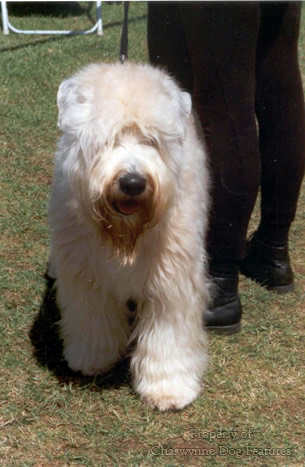 Throughout the 19th and 20th centuries, the sheer fellishness of 'Erin's Dare-devils', as terriers from Ireland were known, was famous. The red-golden coated Irish Terrier, the slate-blue coloured Kerry Blue, the soft-coated Wheaten Terrier and the harsher-coated Glen of Imaal Terrier have never been accused of lacking spirit. The wheaten hue is a common terrier colouration, being found in the Border, Lakeland, Norfolk, Norwich, Cairn and Scottish Terrier breeds, as well as the terriers from Ireland. I have never liked the breed title: Soft-coated Wheaten Terrier; no breed should be identified just by the texture or colour of its coat and there are plenty of wheaten terriers. Such a distinctive and admirable breed deserves a much more precise breed title.
Throughout the 19th and 20th centuries, the sheer fellishness of 'Erin's Dare-devils', as terriers from Ireland were known, was famous. The red-golden coated Irish Terrier, the slate-blue coloured Kerry Blue, the soft-coated Wheaten Terrier and the harsher-coated Glen of Imaal Terrier have never been accused of lacking spirit. The wheaten hue is a common terrier colouration, being found in the Border, Lakeland, Norfolk, Norwich, Cairn and Scottish Terrier breeds, as well as the terriers from Ireland. I have never liked the breed title: Soft-coated Wheaten Terrier; no breed should be identified just by the texture or colour of its coat and there are plenty of wheaten terriers. Such a distinctive and admirable breed deserves a much more precise breed title.
When working in Ireland it was always of interest to study the farm dogs there; so many of them, ungroomed and unclipped, resembled the bouviers of Belgium, the Dutch Terrier or Smoushond and the stable dogs of Germany, the schnauzers. Going to work in Germany, immediately after working in Ireland, allowed me to keep a picture of Irish farm dogs in my mind when viewing their equivalents on mainland Europe. I have seen both schnauzers and wheaten terriers being used as herding dogs in their native countries and appearing interchangeable in form and technique. Two hundred years ago a litter of terrier pups in Ireland could contain coat colours ranging from black and grey, red and tan to silver and gold, wheaten and white. At the first show, in Dublin in 1874, featuring Irish Terriers, one winner was white, another black and tan and another grizzled blue. 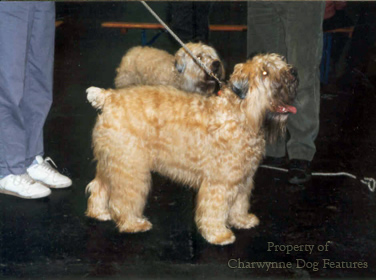
Selective breeding based on breeder and locality preferences concentrated the colour genes of terriers in Ireland into distinct groups which were perpetuated. Breeds reflected those preferences. Dr Carey, first president of the Irish Terrier Club, wrote in 1879, on colour: "Red yellow, wheaten or light brown inclining to grey. The best colour is orange tipped with red, the head slightly darker than the body and the ears slightly darker than the head..." The standard for the Irish Terrier today demands a 'whole-coloured' dog, with black shading highly undesirable.
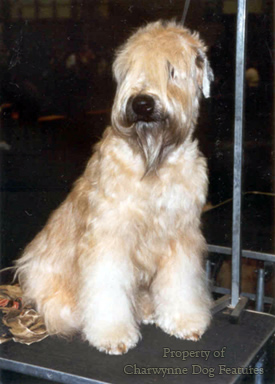 The Kerry Blue is tolerated in any shade of blue with or without black points. The Glen of Imaal can be all shades of blue, brindle and wheaten. I have seen working terriers in Ireland with a shale-grey and a silver coat, with little hint of blue. A show was held in Limerick in 1887 with a class allotted to 'silver-haired Irish Terriers'. In his 'The Twentieth Century Dog', published in 1904, Herbert Compton wrote: "...there was a terrier in County Wicklow (preserved distinct, and highly prized for a century) that was long in body, short in leg, and of a blue-black colour; there was a black terrier in County Kerry..." Soldiers of the House of Hesse, serving in Ireland, may well have brought pinschers with them, which would have produced a harlequin and a red factor.
The Kerry Blue is tolerated in any shade of blue with or without black points. The Glen of Imaal can be all shades of blue, brindle and wheaten. I have seen working terriers in Ireland with a shale-grey and a silver coat, with little hint of blue. A show was held in Limerick in 1887 with a class allotted to 'silver-haired Irish Terriers'. In his 'The Twentieth Century Dog', published in 1904, Herbert Compton wrote: "...there was a terrier in County Wicklow (preserved distinct, and highly prized for a century) that was long in body, short in leg, and of a blue-black colour; there was a black terrier in County Kerry..." Soldiers of the House of Hesse, serving in Ireland, may well have brought pinschers with them, which would have produced a harlequin and a red factor.
HD Richardson, in his 'Dogs, their Origin and Varieties' of 1847, wrote of the harlequin terrier in Ireland: "In form, it is, as it were, a perfect English terrier; in colour it is a blueish slate-colour, marked with with darker blotches and patches, and often with tan about the legs and muzzle. It is one of the most determined of its race..." That doesn't sound like a true harlequin to me, but what has been called 'marled', like clay with a mixture of blue-greys in it.
It is likely that the modern breeds of purebred terriers from Ireland had common ancestors, becoming distinct breeds through county or locality specialisation in coat colour and leg length. It could so easily have been that today's Glen of Imaal Terrier became known as the Wicklow Terrier and the Kerry Blue as the Limerick Blue. Irish Blue Terrier may well be a more apt title for the Kerry Blue. In 1919 a club was formed in Dublin to promote the interests of the Irish Blue Terrier. It was not until 1921 that the name Kerry Blue was finally formally adopted for the breed. The Irish Terrier, before the standard was revised at the end of the 19th century, could be bright red, yellow, wheaten or grey. Grey was subsequently omitted. Half a century ago, blue puppies still featured in red and wheaten litters.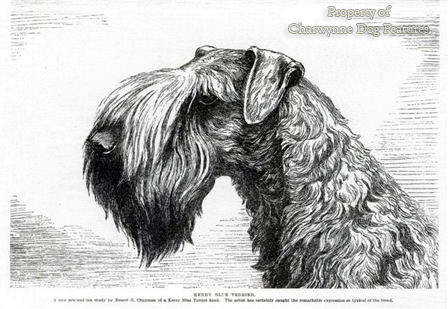
When I was working in County Down some forty years ago, I used to see what could be called straw-coloured terriers on farms there, really like coarsely-bred wheatens. At unofficial dog shows I see classes for what are called 'Irish Staffies', a leggier form of the Staffordshire Bull Terrier. Irish Staffies have every right to their own identity, although this emergent type gets little but scorn from the pedigree world. I don't see why a group of fanciers shouldn't prefer a leggier Staffie; a century ago a comparable group in Staffordshire broke away and created their own breed. The RSPCA is I believe gunning for Irish Staffies, claiming they are substitute Pit Bulls. This is hardly credible; the old dog-fighting men, as Fitz-Barnard, Stevens, Armitage and Colby point out in their books on them, never favoured a leggy dog, believing from experience that it allowed opponents to get under them.
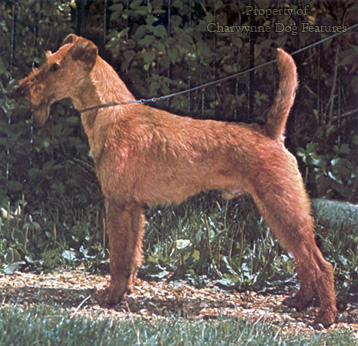 A longer-legged Irish Staffie would be better described as an 'Irish Bull Terrier' so that the height and weight limitations linked to pedigree Staffordshire Bull Terriers didn't lead to assumptions of their misuse in dog combat. The Bull Terrier does not have weight and height restrictions in its KC breed standard. But the loose title Irish Staffie is not a recent innovation. Forty years ago in Ireland I used to hear of the Norford or Northern Ireland Staffordshire Bull Terrier, usually a dog with blue in its coat, rather like the Blue Paul in Scotland. The red tan dogs were called Dublin Reds. Terrier tests have been favoured in Ireland for some years, even by the Irish Kennel Club.
A longer-legged Irish Staffie would be better described as an 'Irish Bull Terrier' so that the height and weight limitations linked to pedigree Staffordshire Bull Terriers didn't lead to assumptions of their misuse in dog combat. The Bull Terrier does not have weight and height restrictions in its KC breed standard. But the loose title Irish Staffie is not a recent innovation. Forty years ago in Ireland I used to hear of the Norford or Northern Ireland Staffordshire Bull Terrier, usually a dog with blue in its coat, rather like the Blue Paul in Scotland. The red tan dogs were called Dublin Reds. Terrier tests have been favoured in Ireland for some years, even by the Irish Kennel Club.
The Teastas Begg or small test involved the hunting of either a rabbit in a field (a scenting test) or a rat in a stream (a catch and kill test). The Teastas Mor or large test involved the use of a live badger in an artificial set, the employment of an earth dog to drive the wretched badger into a further 'shore' or widened tunnel, so that a strong dog could be tested on it from the other end. The bigger terrier then had to draw the badger in under six minutes, whilst remaining totally mute, silence being associated with courage. Around 1966 public opinion rightly brought an end to these cruel acts but clandestine tests may well be still going on. Independent field trials held sixty years ago by the Working Terrier Association of Ireland led to accusations that Kerry Blues were being crossed with bull terriers from England. The original IKC tests were for purebred dogs only, rather as gundogs can gain their working test certification. At one time no Glen of Imaal Terrier was allowed to become a full champion without its Teastac Misneac or dead-game certificate.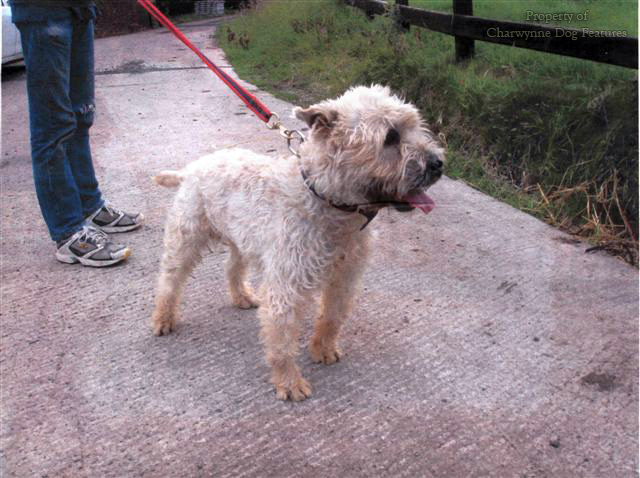
Whatever their breed title, whether registered as a breed or not, the native terrier breeds of Ireland should be treasured. Each one is very different from the other. I do hope that the Irish Wheaten, as I prefer to call them, doesn't fall victim to its profusion of coat, which seem heavier here than in Ireland. With soft-coated in the breed title, Ireland's 'gentle terrier' as I've heard then dubbed, and with more of them in America than in Ireland, their working instincts deserve more attention.
The Kerry Blue will always be distinctive, but I've seen them with large thick ears, short on the leg and heavier in the skull than previously. Their coats seem to be becoming heavier too. I've seen working Irish Terriers featuring a woollier coat and a white brisket in Ireland, the outcross to the Wire-haired Fox Terrier possibly manifesting itself. I always look for a racier build in them, with a good arch over the loin and a good length of body. The Glens have their own style, with strong bone, distinctive front legs and plenty of attitude. I am told that the Sporting Glen Club in Ireland has 120 members, with a dozen people still working the breed. I was told of Red Ned, a famous working Glen of the 1950s, and that about then, the Earl of Rocksavage had two formidable Glens on his estate in Ireland. You underestimate the terriers of Ireland at your peril!